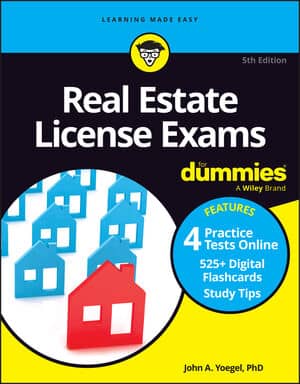It’s important to remember for the Real Estate License Exam that the terms and conditions of a particular mortgage loan can differ from those of any other mortgage loan. But most mortgage loan arrangements have a number of terms and conditions in common and some of them may show up on the exam.
Duties of the borrower
In a typical mortgage loan, the borrower commits to a number of obligations that are written into the mortgage or note documents. These include:
Paying off the debt under the conditions as specified in the note, which includes the interest rate and payment schedule.
Indicating the property that the mortgagor (borrower) is using as security.
Paying all real estate taxes on the property.
Getting permission from the lender before doing any major repairs, alterations, or demolition.
Protecting the lender’s interest by maintaining a property hazard insurance policy on the property in case unforeseen damages occur.
Adequately maintaining the property.
The acceleration clause
Mortgage loan agreements frequently include stipulations that are known as acceleration clauses, which effectively protect the lender from a loan for which the borrower is in default. Default is a situation in which borrowers don’t fulfill the obligations of their mortgage loan agreements. An acceleration clause takes effect when the buyer is declared in default. The acceleration clause enables the lender to require the entire debt to be repaid immediately.
So, if you defaulted on the $100,000 loan that you were going to pay off over 30 years, it may be due in full — tomorrow, that is, if your mortgage agreement includes an acceleration clause. The payments are sped up so that the entire amount is due immediately.
Points on mortgage loans
Sometimes lenders charge additional interest at the beginning of the loan that is based on the amount of the loan. This additional interest is called points or sometimes discount points.
A point equals 1 percent of the loan amount, and that’s something you don’t want to forget, because it’s a common math question. And remember, a point is not 1 percent of the sale price of the house — unless, of course, the borrower is in the unusual position of being allowed to borrow the entire price of the property, but 1 percent of the loan amount.
A bank agrees to make a mortgage loan of $100,000 to a property buyer. The bank agrees to a lower-than-normal annual interest rate on the condition that the buyer pay 2 points to the bank at closing. How much does the buyer have to pay in points?
$100,000 x 0.02 = $2,000
This additional prepaid interest usually results in a lower interest rate for the loan as it is paid up. For example, a lender may charge you a 7 percent interest rate with no points but give you a 6.75 percent interest rate, if you pay 1 point at the beginning of the loan.
Throughout the loan’s life, the lower rate means you pay about the same total amount of interest, but your monthly payments are slightly lower, and the yield, or overall profitability of the mortgage as an investment, stays appealing to private investors.
The combination of the interest that is paid along the way plus the points charged in prepaid interest combine to form the annual percentage rate (APR), which is the real interest rate you’re paying.
When points are paid to lower the interest rate, it’s called a buydown. The buydown can be applied to lower the interest rate over the life of the loan or for a specific period of time, like the first year or two.
Borrowers who use their buydowns to lower the interest rate during the short term usually are anticipating larger incomes later on during their loan repayment schedules. Builders of new homes may pay points to lower the interest rate for a few years to attract buyers to their development. This is usually referred to as a seller incentive.
Points sometimes are used to calculate loan origination fees. A borrower may pay one or two points — 1 percent or 2 percent of the loan amount — to the lender for administrative charges associated with the loan. This payment, however, won’t reduce the interest rate on the loan. Origination fees sometimes are paid to mortgage brokers, who are individuals who arrange loans between borrowers and lenders.
Points are sometimes paid to lock in the interest rate for a period of time. A borrower may want to assure himself that the interest rate in effect at the time he applies for the loan is the same rate in effect at closing. The bank usually charges a fee for this, sometimes using points to calculate how much to charge for the rate lock.
Escrow
An escrow account, which is required by most lenders, is an account held by the bank on behalf of the borrower that is used by the lender to pay the taxes and insurance on the property. The lender normally calculates a monthly payment that includes the mortgage payment and a portion of the annual taxes and insurance costs.
The bank pays itself with the mortgage payment and accumulates the tax and insurance portion in the escrow account, making the appropriate payments as they come due.
Tax liens are first in priority ahead of all other liens. That means if the property is sold for nonpayment of the mortgage loan, and taxes are due on the property, the taxes get paid first. If not enough money is left over from the sale to pay the mortgage loan, the lender can be stuck with the loss. To avoid this situation, the lender handles the payment of taxes.
You may see other terms on an exam that mean the same thing as escrow account, including reserves, impounds, and trust accounts.

